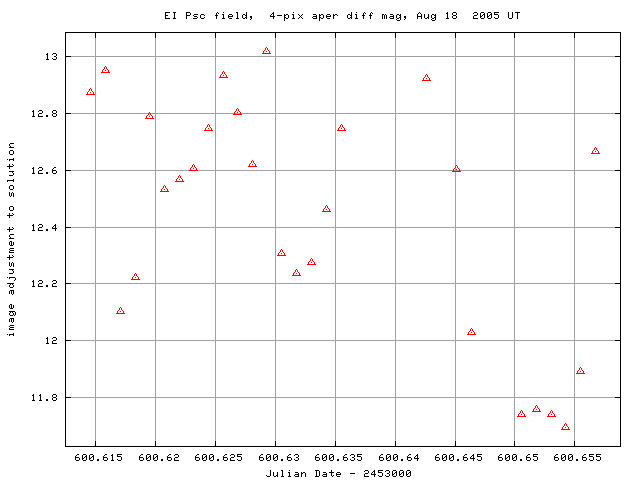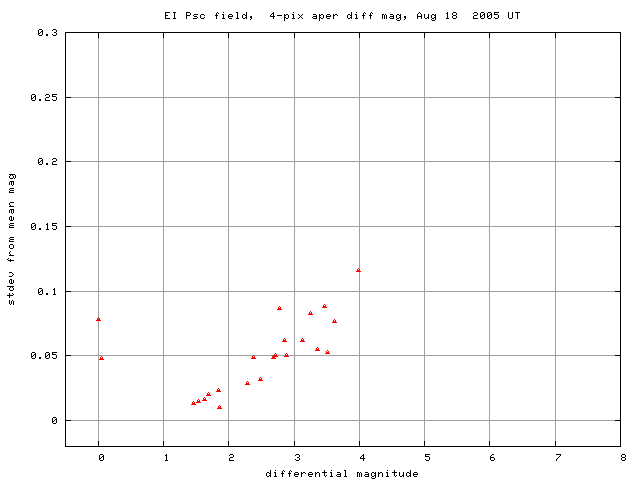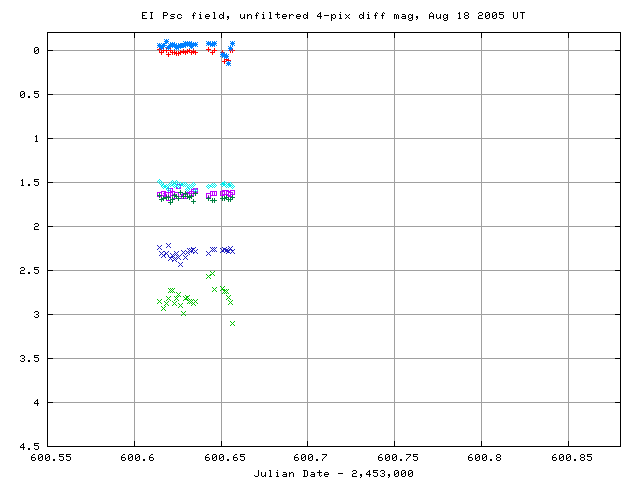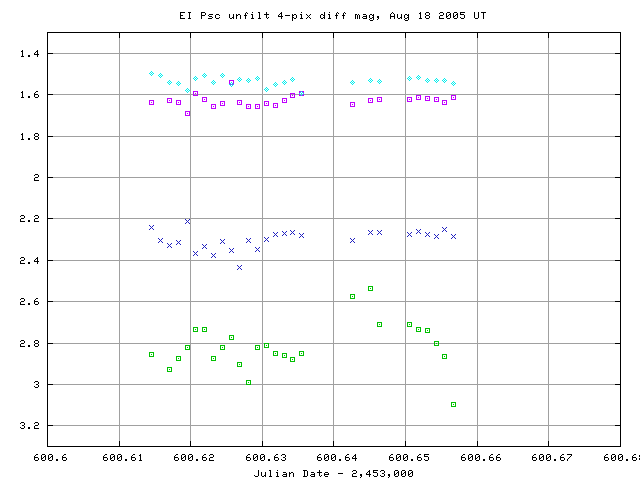
On the night of Aug 17/18, 2005 EDT, I used the RIT Observatory's 12-inch Meade telescope and SBIG ST8 CCD camera to monitor the cataclysmic variable star EI Psc (also known as 1RXS J232953.9+062814) as it was near the peak of its outburst. We are acting on behalf of the Center for Backyard Astrophysics, VSNET, and all others who study these very interesting variable stars.
The plan:
Notes from the night

You can read about EI Psc in these articles:
The stars marked "A" and "B" were used as comparisons in the 2001 superoutburst, according to the Uemura et al. papers. Here is the rather poor information I can find about them:
USNO B1.0 mags
star GSC_1.2_ID USNO B1.0 ID RA (J2000) Dec B R
----------------------------------------------------------------------------
A 0591.1689 0964-0601121 23:30:02.7 +06:24:37 13.64? 11.83?
B 0584.366 0963-0598647 23:29:49.9 +06:22:11 12.4 12.85
----------------------------------------------------------------------------
I have used star "B" to set the zeropoint of my unfiltered measurements. I create a pseudo "V-ish" magnitude by the simple calculation (B+R)/2 based on the USNO B1.0 magnitudes, and end up with "V-band" mag = 12.63.
Yes, I know now that there is a good measurement of V = 12.2 for star "A", so that my differential measurements have a systematic offset of about +0.5 magnitudes. However, I will continue to use this (incorrect) zero-point for my unfiltered measurements for internal consistency.
MWR 8/17/2005And yes, on this particular night (UT Aug 18), stars "A" and "B" were both slightly saturated.
MWR 8/18/2005
I measured the instrumental magnitude of each star with aperture photometry, using a radius of 4 pixels = 7.5 arcseconds and sky defined by an annulus around each star. Following the procedures outlined by Kent Honeycutt's article on inhomogeneous ensemble photometry, I used all stars available in each image to define a reference frame, and measured each star against this frame.
Below is a graph of the scatter in differential magnitude versus magnitude.

Note how large the scatter is for all stars compared to the scatter on good nights. I excluded "A" and "B" from full participation in the photometric ensemble, which explains their very large scatter. EI Psc is the star with slightly elevated scatter around differential mag 2.9.
Light curves for selected stars in the field are shown below. EI Psc is shown by light green crosses near the bottom.

Here's a closeup of the variation in EI Psc itself, with the comparison stars "C" (in purple), "D" (in aqua), and "F" (dark blue). I can't really say anything about any variations of EI Psc within the run; the sharp decline in the final few points may be real, but that is about all I would believe.

What is clear is that EI Psc is much fainter than it was just 24 hours ago. As our analysis of the UT Aug 17 data shows, EI Psc was about 0.2 mag fainter than star "C" (purple) then; it is about 1.2 mag fainter than "C" now.
I've made a table of the measurements themselves, with three different flavors of time. The differential unfiltered magnitudes from the ensemble solution has been shifted so that star "B" in my chart, has value 12.63, matching a very rough guess at its V-band magnitude, based on B and R mags in the USNO B1.0 catalog. Remember, because the comparison star "B" was slightly saturated tonight, this offset might be bad.
Here's the start of the table.
# Measurements of EI Psc made in poor conditions at RIT Obs, Aug 18, 2005 UT, # made by Michael Richmond. # All data taken with 12-inch LX-200 + no filter + SBIG ST-8 CCD # no focal reducer, so at native f/10 # Each exposure 30 seconds long; tabulated times are midexposure # and accurate only to +/- 1 second. # 'mag' is a differential magnitude based on ensemble photometry # which has been shifted so USNOB1.0 0963-0598647 has mag=12.63 # (a rough guess = (B+R)/2 and the USNO B1.0 magnitudes). # Warning: this star may have been slightly saturated! # # UT day JD-2,450,000 HJD-2,450,000 mag uncert Aug18.11457 3600.61457 3600.61955 15.486 0.063 Aug18.11705 3600.61705 3600.62203 15.560 0.058 Aug18.11828 3600.61828 3600.62326 15.503 0.058
Last modified 8/18/2005 by MWR.